|
Introduction
The members of the
genus Cirrhilabrus are widely known as the Fairy Wrasses
and have recently gained popularity among aquarists, reefkeepers
and divers. The genus belongs to the family Labridae and includes
43 species from the Indo-West Pacific, the Red Sea, the Hawaiian
Islands, the Marshall Islands and the Society, Pitcairn and
Tuamotu Islands to the east. A few species are widely distributed,
but most are limited to a small geographic area and/or are
found only in a deepwater habitat. Some have not yet been
reported outside the locality where they were originally discovered.
They are known to form harems comprised of a large dominant
male, and several smaller females and juveniles; each stage
of their development, from juveniles to full adults, is usually
marked by different coloration. The males of each species
have an ability to change their coloration to a more gorgeous
one, with brilliantly colored dots, lines and areas on their
body and fins as they "flash," especially when courting.
Such coloration is widely believed to attract the females
of the same species to spawn eggs in the water column. The
males' movement is very quick and they are known to change
colors rapidly and repeatedly, especially in the evening
and early morning. Divers will be astonished to see their
flashings, but aquarists in their homes can also witness their
amazing behavior even when the male is kept without a mate
in a captive environment.
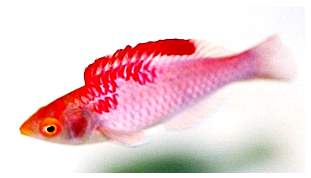 |
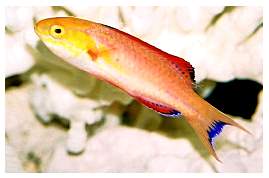 |
|
Figure 1 (left). A Cirrhilabrus adornatus,
male, 65mm, from Indonesia. These are a rarely sold
species collected for sale only from western Sumatra
and are one of the species that has recently entered
the aquarium trade. Figure 2 (right). A C.
johnsoni, male, 65mm, from the Marshall Islands.
It is not uncommon in its natural habitat but is very
rarely sold and commands a very high price because collectors
do not often go to far away places such as the Marshall
Islands. It is imported for the aquarium trade via Hawaii.
|
Cirrhilabrus
Availability in Japan
|
Species/locale
|
Availability
|
| adornatus
- (Randall & Kunzmann, 1998) - Sumatra, Indonesia |
Very
rarely seen in the aquarium trade; only males are available;
rather expensive. |
| aurantidorsalis
- (Allen & Kuiter, 1999) - Sulawesi, Indonesia |
Very
common; inexpensive. |
balteatus
- (Randall, 1988) - Marshall
Islands |
Very
rare; very expensive. |
| bathyphilus
- (Randall & Nagareda, 2002) - Coral Sea & Vanuatu |
Very
rare from the Coral Sea; fairly regularly shipped from
Vanuatu; variable in coloration; very expensive. |
| blatteus
- (Springer & Randall, 1974) - Red Sea |
Not
available. |
| brunneus
- (Allen, 2006) - Kalimantan, Indonesia |
Not
available but very similar specimens (same species?) are
available occasionally from Sulawesi; rather expensive. |
claire
- (Randall & Pyle, 2001) - Cook
Islands |
Not
available. |
| condei
- (Allen & Randall, 1996) - Papua New Guinea &
Vanuatu |
Rare,
only from Vanuatu; rather expensive. |
cyanopleura
- (Bleeker, 1851) - West
Pacific |
Very
common; variable in coloration; cheap. |
| earlei
- (Randall & Pyle, 2001) - Palau & Marshalls |
Not
available. |
exquisitus
- (Smith, 1957) - Indo-West
Pacific |
Very
common; variable in coloration; cheap. |
| filamentosus
- (Klausewitz, 1976) - Java Sea, Indonesia |
Very
common; cheap. |
| flavidorsalis
- (Randall & Carpenter, 1980) - Indonesia, Philippines,
Malaysia & Palau |
Common;
cheap. |
| joanallenae
- (Allen, 2000) - Sumatra, Indonesia |
Scarce;
inexpensive. |
| johnsoni
- (Randall, 1988) - Marshalls & Palau |
Very
rare; very expensive. |
| jordani
- (Snyder, 1904) - Hawaiian, Johnston & Midway Islands |
Rather
rare; rather expensive. |
katherinae
- (Randall, 1992) - West
Pacific |
Very
rare; fairly expensive (actually, some are variants of
temminckii). |
katoi
- (Senou & Hirata, 2000) -
Japan |
Very
rare; very expensive. |
| laboutei
- (Randall & Lubbock, 1982) - South Pacific |
Fairly
common; expensive. |
| lanceolatus
- (Randall & Masuda, 1991) - Japan |
Not
available. |
| lineatus
- (Randall & Lubbock, 1982) - South Pacific |
Fairly
common; rather expensive. |
| lubbocki
- (Randall & Carpenter, 1980) - Indonesia, Philippines,
Malaysia & Palau |
Very
common; cheap. |
| lunatus
- (Randall & Masuda, 1991) - West Pacific, Indonesia
& New Caledonia |
Rare;
variable in coloration; only from Sulawesi and Cebu; rather
expensive. |
luteovittatus
- (Randall, 1988) -
Marshalls |
Common;
inexpensive. |
| marjorie
- (Allen, Randall & Carlson, 2003) - Fiji |
Not
available. |
| melanomarginatus
- (Randall & Shen, 1978) - Japan to Philippines &
Vietnam |
Very
rare; very expensive. |
| morrisoni
- (Allen, 1999) - off Western Australia |
Not
available. |
| punctatus
- (Randall & Kuiter, 1989) - South Pacific |
Fairly
common; highly variable in coloration; rather expensive. |
| pylei
- (Allen & Randall, 1996) - Papua New Guinea, Vanuatu,
Indonesia & Cebu |
Rather
rare (Sulawesi- fairly common; Vanuatu- rare; Cebu- extremely
rare); very expensive. |
| randalli
- (Allen, 1995) - off Western Australia |
Not
available. |
| rhomboidalis
- (Randall, 1988) - Marshalls & Palau |
Rather
rare; expensive. |
| roseafascia
- (Randall & Lubbock, 1982) - New Caledonia, Palau,
Fiji, Samoa & Cebu |
Very
rare; from Cebu only; rather expensive. |
| rubrimarginatus
- (Randall, 1992) - West & South Pacific |
Very
common; not expensive. |
| rubripinnis
- (Randall & Carpenter, 1980) - Philippines &
Indonesia |
Very
common; cheap. |
| rubrisquamis
- (Randall & Emery, 1983) - Chagos, Maldives &
Sri Lanka |
Rather
rare; rather expensive. |
| rubriventralis
- (Springer & Randall, 1974) - Red Sea, Oman &
Sri Lanka |
Very
common; probably all from Sri Lanka; cheap. |
sanguineus
- (Cornic, 1987) -
Mauritius |
Scarce;
extremely expensive. |
| scottorum
- (Randall & Pyle, 1988) - South Pacific |
Fairly
common; expensive. |
solorensis
- (Bleeker, 1853) -
Indonesia |
Very
common; inexpensive. |
| temminckii
- (Bleeker, 1853) - West Pacific & Western Australia |
Very
rare, mainly from Bali, Sulawesi & Malaysia; rather
expensive. |
| tonozukai
- (Allen & Kuiter, 1999) - Indonesia & Palau |
Fairly
common; vary from cheaper to rather expensive. |
| walindi
- (Allen & Randall, 1996) - Papua New Guinea |
Not
available. |
walshi
- (Randall & Pyle, 2001) -
Samoa |
Not
available. |
Several species are very popular among
marine aquarists and some are usually obtainable at reasonable
prices, while some have not yet found their way into the aquarium
trade because of their rarity, deep-water habitat or very
limited distribution in remote areas. Some 15 years have passed
since I first purchased specimens of Cirrhilabrus that
were sold simply as "wrasse species" at a retailer.
As little as 10 years ago there was no good book available
that showed the many Cirrhilabrus species, and many
incorrect names, including "parrotfishes," were
applied to these species in various literature published in
the early 1990s. Rudie Kuiter's magnificent wrasse book (2002)
shows many fairy wrasses for the first time with numerous
color illustrations, and this book alone has successfully
created many new enthusiasts for the species. People who love
the fairies suddenly increased in number, as did columns devoted
only to this genus on several websites. Many articles specifically
detailing the genus have appeared in several popular magazines,
and now its species have become very popular among reefkeepers
as they are recognized as "reef-safe" fishes. Yes,
they can be great additions to any type of aquaria with or
without live corals, fish-only or reef tanks.
Cirrhilabrus species are easy to keep in aquariums
that provide enough open space for free-swimming, and many
crevices for hiding. They are plankton feeders in the sea
and feed well on most prepared foods shortly after introduction
to captivity, and many species also are very peaceful. Some
Cirrhilabrus species may take foods directly from their
keeper's hand. They can be kept in small tanks of 60 x 30
x 30 cm minimum dimensions, but it is advisable to prepare
larger tanks to maintain them for a long period of time. There
is no need to provide them with a sand bed; they are not sand
sleepers but produce a cocoon while they are sleeping, most
often among or under rocks or corals. Any tank housing these
wrasses should be covered, because they may jump out of the
water when danger approaches. Now let me discuss some of this
genera's rare or even newly introduced species.
Species Discussion
While generally not available until
2005, the Adorned (or Decorated) Fairy Wrasse, Cirrhilabrus
adornatus (see Figure 1), comes
from the western coast of Sumatra and its offshore islands.
The males are snow white, have two striking red markings on
their back and have a red dorsal fin. It was recently described
and was first regarded as a small species, but one of my friends
in Thailand informed me that he has seen several males over
10 cm long. Females are red overall with a white abdomen and
a black spot on their caudal peduncle, like other females
of most species in this genus. This fish was first discovered
by the famous German diver, Helmut Debelius, so it is also
commonly called Debelius' Fairy Wrasse. The species first
entered the aquarium trade in 2005 as far as I know, but only
a few have been shipped to Japan. Only males were available
initially, but in the USA females also are available nowadays.
Johnson's Fairy Wrasse, C. johnsoni (Figure
2) is sometimes a fairly shallow water inhabitant with
some encountered at 15-30 meters depth but most will be found
at 60-75 meters depth. Their distribution is restricted to
the Marshall Islands and Palau, so it is not commonly seen
in the aquarium trade. Only recently have those from the Marshall
Islands gained popularity with the help of a few enthusiastic
collectors at great depths, but they still are rarely sold.
The Exquisite Fairy Wrasse, C. exquisitus (Figure
3), is a beautiful species with an unusual black spot
on its caudal peduncle even in adult males. It is widely distributed
from African coasts and throughout Indian Ocean islands, southeast
Asia, southern Japan, Micronesia, the west and east sides
of Australia and out to the Tuamotu Islands in the east. Several
morphs are known in this species and some ichthyologists hope
to divide it into several distinct species. Males from the
Indian Ocean have a red marking behind their eye, while those
from the Pacific possess red outer margins on their dorsal
and anal fins and lack the red marking behind their eyes.
Males from Fiji and Rowley Shoals also are distinctly colored
but currently no diagnostic differences are known by ichthyologists.
The Scotts' Fairy Wrasse, C. scottorum (Figure
4), often called the Velvet wrasse, is another variably
colored species that ranges widely throughout the South Pacific
from the Great Barrier Reef to the Society, Tuamotu and Pitcairn
Islands. It can reach a full adult size of up to 14 cm in
length. It usually has a red tail and often has a red blotch
on its side, but some individuals are known to lack these
blotches. The very closely related C. melanomarginatus,
from the northwestern Pacific, has a green tail. They do not
co-occur in any range, and some "original
species" were divided into these two distinct species.
Females of both species are almost identical in appearance.
|
Figure 3. A C. exquisitus, male, 10cm,
from Kenya. A truly wide ranging species of the genus.
|
|
Figure 4. A Cirrhilabrus scottorum, male,
14cm, from the Cook Islands. As seen in this photo,
fully grown males have a filamentous tip on their caudal
fin.
|
Some members of Cirrhilabrus have a very limited distribution,
and C. sanguineus (Red-blotched Fairy Wrasse) is a
perfect example (Figure 5). It was
described from Mauritius and is very rarely seen in its natural
habitat and, therefore, seldom enters the aquarium trade.
I've seen this species at retailers only three times in the
15 years I've studied these fish, and I was fortunate enough
to purchase a small male and a larger one. The males have
an outstanding purple-red area on the middle of their sides
and their background is pale pinkish-white. A dark grey area
behind the head and a long tail also are characteristics of
large males. When the male is excited, a pale stripe appears
on each side of its head and his pelvic
fins change from pinkish to a deeper orange color. This behavior
occurs within just seconds, and they soon return to their
normal coloration.
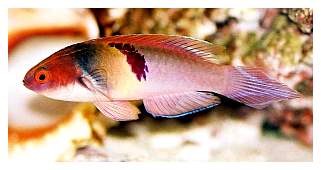 |
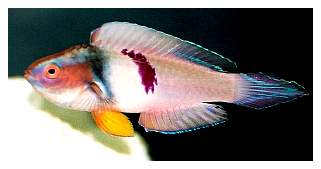 |
|
Figures 5 & 6. Both photos show a Cirrhilabrus
sanguineus, 8cm, from Mauritius (same specimen).
While the male is displaying, seen here in the photo
on the right, some areas change to different colors.
|
The Temminck's Fairy Wrasse, C. temminckii (Figures
7, 8 & 9 below) has several color morphs that have confused
many divers and aquarists, and several ichthyologists believe
that the species should be divided, but it is now widely regarded
as a single species. This species is known from the western
Pacific including southern Japan, Taiwan, the Philippines,
Indonesia, Malaysia, Vietnam and Western Australia. Two separate
groups exist, with "Group A" being known only from
southern Japan to Malaysia and the Indonesian region. Their
stripes are known to turn blue when the male is excited and
thus members of "Group A" are often called Blue-stripe
Fairy Wrasses; they have two distinct stripes on their side.
"Group B" hails from Australia, and they have a
red & white body. Three species are closely related to
C. temminckii: C. katherinae, C. punctatus
and C. balteatus.
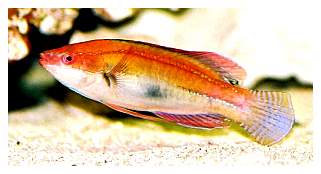 |
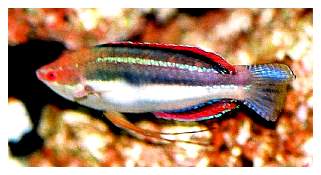 |
|
Figures 7 & 8. A C. temminckii, "Group
A," from Indonesia, male (same specimen), 8cm.
The right shot illustrates its spawning display coloration
from which its common name, the Blue-stripe Fairy Wrasse,
is derived.
|
|
Figure 9. A C. temminckii, "Group
A," male, 12cm, from Malaysia. This species has
an entirely dark body with reddish stripes on its side
that can turn blue.
|
|
Figure 10. A C. katherinae, male, 6cm,
from Cebu.
|
Figure
11. A C. punctatus, male, 14cm, from Australia.
|
|
Figure 12. A C. punctatus, male, 12cm,
from Vanuatu. They are often mistaken for C. temminckii
and are sometimes called the Port Vila Fairy Wrasse
after Port Vila, which is located on Vanuatu.
|
Katherine's Fairy Wrasse, C. katherinae
(Figure 10) is found throughout the
western Pacific, including southern Japan, Taiwan, the Philippines
and the Mariana Islands. It is very similar to C. temminckii
but has a black spot on the base of its pectoral fin. Cirrhilabrus
temminckii does not possess such a spot there but the
males shown here (Figures 7, 8 & 9)
have the spot, so it's likely that these variants will be
separated into a distinct species in the future.
|
|
|
Figure 13. A rare import to the trade, this Cirrhilabrus
balteatus (male, 11cm) hails from the Marshall Islands.
|
The Dotted or Fine-spotted Fairy Wrasse,
C. punctatus (Figures 11 &
12 above) comes from the South Pacific, mainly from the
Great Barrier Reef of Australia and Fiji, and it will soon
be shipped to the aquarium trade from Vanuatu as well. This
species is highly variable individually, but males from New
Caledonia and Vanuatu are almost identical in appearance.
I suspect that those from these areas would be at least classified
as a subspecies, not a geographical variant.
The Girdled or Belted Fairy Wrasse, C. balteatus (Figure
13 above), is known only from the Marshall Islands and is
distinct by having an orange-yellow square on its side.
Conde's Fairy Wrasse, C. condei, (Figures 14 &
15 below) was originally described from Papua, New Guinea
and is one of the newer aquarium imports from Vanuatu. Males
from Vanuatu have an outstanding black dorsal fin with a yellow
band on its upper side, but those from Papua, New Guinea have
an additional red band on the basal side of their fin and
specimens from the latter have never entered the aquarium
trade as far as I know.
|
Figures 14 & 15. Two photos of a male Cirrhilabrus
condei (same specimen), 7cm from Vanuatu. Its body
and tail turn bright pink while performing the spawning
display.
|
|
Figure 16. Cirrhilabrus pylei,
male, 10cm from Vanuatu.
|
Figure
17. Cirrhilabrus pylei, male, 9cm
from Cebu.
|
Figure
18. Cirrhilabrus pylei, male, 9cm
from Sulawesi.
|
The Pyle's Fairy Wrasse, C. pylei (Figures 16, 17
& 18 above), is also one of the newcomers from the western
Pacific, mainly from Sulawesi (Indonesia) and Vanuatu. A few
specimens from Cebu will be shipped but only rarely. This
species has three distinct color morphs: males from Vanuatu
have a broad red zone on their dorsal fin, those from Cebu
have a conspicuous black spot and a black band on their fins,
and those from Sulawesi lack both of these. It is my belief
that these are purely geographical variants.
Another new and quite striking species
from Vanuatu (Figure 19) should be
added here, for it already has been found in the aquarium
trade, and also because I love it so much. It was once regarded
as a variant of C. bathyphilus (Deep-sea Fairy Wrasse),
which was described in 2002. It differs in coloration, however,
by having a red hood and a yellow body. I suspected that it
could be an entirely new species so I sent four specimens
to the genus' expert, Dr. John E. Randall of Oahu, for his
examination some time ago, but he determined that it was not
a new species. At his suggestion I am currently co-authoring
a scientific paper with a friend in Australia on these fish
with two distinct color morphs, with the intent to re-describe
this species. The "true" C. bathyphilus is
restricted to the northern Great Barrier Reef around Holmes
Reef and Chesterfield Bank, near New Caledonia.
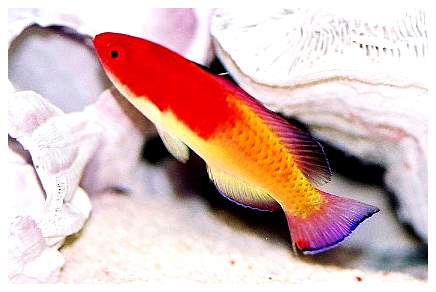 |
|
Figure 19. One of the "subspecies"
of C. bathyphilus (male, 7cm) from Vanuatu. It
is called the Hooded Fairy Wrasse by collectors in Vanuatu.
|
Recent shipments from Cebu (the Philippines) have included
many unusual specimens, one of which is the deep water species
C. roseafascia, the Rose-band or Redstripe Fairy Wrasse
(Figure 20). It was described from
New Caledonia and only the single, juvenile specimen has been
known since its discovery. At the end of the 1990s a diver
in Palau photographed a young male that was reported as the
first record of C. lanceolatus from Palau. Later, an
ichthyologist photographed and collected several specimens
by deep diving (over 100 meters deep) in Fiji and Samoa, and
only recently have divers from Japan photographed some specimens
in Cebu. Cirrhilabrus roseafascia is closely allied
with and very similar to C. lanceolatus, which is endemic
only to southern Japan. The species reaches over 20 cm in
length and is presently the largest member in the genus. I
obtained several specimens, all collected in Cebu, and some
of them are still very gracefully swimming in my tanks.
An apparently new species from Cebu, popularly
called the Pin-tail Fairy Wrasse, C. species (Figure
21), is rarely sold at retailers and commands a high price
due to its rarity and its deep water habitat. It was first
collected for scientific examination at Iriomote Island in
the Ryukyu Islands, and several additional specimens were
collected in Taiwan in May 2005. Currently, some specimens
are collected in Cebu for the aquarium trade, but this is
not done on a regular basis. This as yet unnamed species can
be differentiated by having two pinkish stripes on its side,
a long tail and a yellowish area on its head and the center
of its body. Many native divers have photographed them in
the Izu Islands and in southern Japan, but only at great depths.
|
Figure 20. A Cirrhilabrus roseafascia,
male, 15cm, from Cebu. It often is misidentified as
C. lanceolatus, but has a blackish blue spot
on the posterior part of each pelvic fin's base.
|
|
Figure 21. An unnamed Cirrhilabrus species,
commonly called the Pin-tail Fairy Wrasse. This is a
male, 7cm in length, from Cebu. It likely will be assigned
a species name soon.
|
Several species are yet to be named, and
one of them is shown here (C. species, Figure 22).
It closely resembles the Red-fin fairy wrasse, C. rubripinnis
(Figure 23), but has a broader red area at its dorsal fin's
posterior base. Its dorsal fin is deeper red and its anal
fin is a deep purplish red, while C. rubripinnis' dorsal
and anal fins are equally red. This apparently new species
comes from the shallow waters of southwestern Sulawesi and
should be named soon.
|
Figure 22. A Cirrhilabrus species, an
unnamed specimen from southern Sulawesi, Indonesia (male,
some 7cm). Figure 23. A Cirrhilabrus rubripinnis,
male, 7cm, from the Philippines.
|
Conclusion
Several "probably
unnamed species" are now being studied and are soon to
be described by various authors in 2006-2007. Fairy wrasses
have recently become very popular and have attracted both
seasoned and new aquarists alike with their amazing hues and
beautiful coloration. Fairy wrasses' easiness to keep and
their ability to thrive in both fish-only community tanks
and reef tanks make them wonderful aquarium habitants. Additionally,
their unexpected and remarkable color changes will astonish
any aquarist, and this behavior can be enjoyed even in captivity
with careful observation. My ultimate goal and dream is to
one day gather all the species and all their stages in one
huge tank.
All photos copyrighted and taken by Hiroyuki
Tankaka, MD.
|

